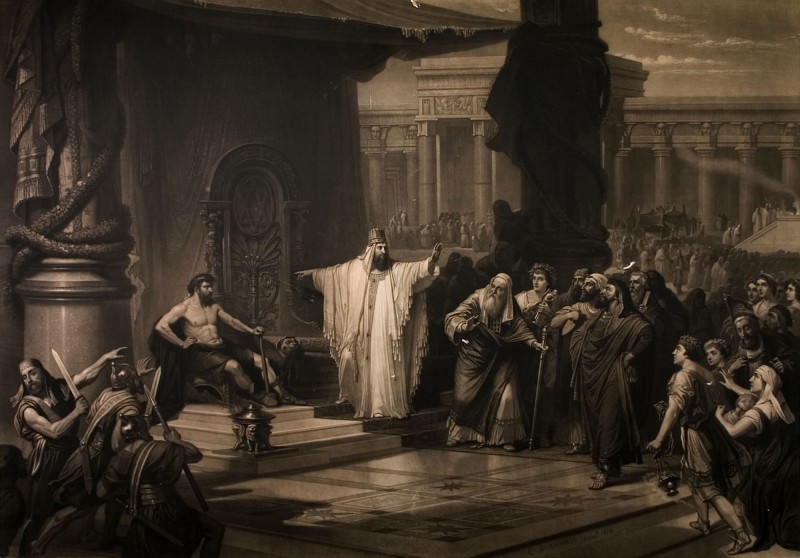his spectacular Artist’s Proof is from a steel engraving made by John Sartain of a painting by Christian Schussele, The Iron Worker and King Solomon. Made in 1871, it was donated to the Grand Lodge of New York’s Library and Museum in the late 1880s. It is quite large, measuring 3 1/2 feet x 2 1/2 feet, and is signed by both C. Schussele and John Sartain. Next to John Sartain’s signature is printed, in all capital lettering, “Artist’s Proof.” See the full artifact record in the Online Museum by clicking here.
Beneath the image is printed the Jewish legend about this event, which reads as follows:
“When the Temple at Jerusalem was completed, King Solomon gave a feast to the artificers employed in its construction. On unveiling the throne, it was found that a blacksmith had usurped the seat of honor on the right of the King’s place, not yet awarded. Whereupon the people clamored and the guard rushed to cut him down. “Let him speak!” commanded Solomon.
“Thou hast, o king, invited all craftsmen but me, yet how could these builders have raised the Temple without the tools I fashioned?”
“True,” decreed Solomon, “The seat is his of right. All honor to the Iron-Worker.”
“The first temple – known as King Solomon’s Temple -…was the grandest and costliest edifice ever erected….King David, having reached a period in his administration when the Jewish nation was at peace with all the world, commenced preparations for the erection of a Temple to Almighty God, and where the Ark of the Covenant could be placed and kept in security; but as he had been engaged in wars and caused the shedding of blood, he was ordered, by the Prophet Nathan, to collect materials, and that his son Solomon should build the House of the Lord.
“For this purpose, David had numbered the workmen he found in his kingdom; had appointed the Overseers of the work, the hewers of stone and the bearers of burdens; had prepared a great quantity of brass, iron and cedar, and had amassed an immense treasure, having collected more than four thousand millions of dollars, and one hundred and eighty-four thousand, six hundred men. When Solomon ascended the throne, he commenced to carry in to effect the designs of his father, King David. For this purpose he sought the assistance of Hiram, King of Tyre.
“The Tyrians and the Sidonians had long been distinguished for their great architectural skill; and in fact many of them, as the members of a mystic operative society – the Fraternity of Dionysian Artificers – had long monopolized the profession of building in Asia Minor. Hiram, King of Tyre, sent Solomon 33,600 workmen from Tyre, besides a sufficient quantity of timber and stone to construct the edifice which he was about to erect. He also sent him a far more important gift than either men or materials in the person of an able architect – ‘a curious and cunning workman.’ ”
In the engraving, “the man who has usurped the chosen seat of honor is displayed in all the strength of manhood: Muscles of iron and a power of will unconquerable, a feeling of safety despite the turbulent outcries of the populace, not even deigning to rise when addressing the craft, he sits, the embodiment of perfect security and trust. The Jewish soldiers…seem as if they too would contend with Tubal Cain’s successor, and assert the supremacy of the martial over the mechanic.
“…Then said the man to Solomon, ‘Behold, O king! I am he whom, when men deride, they call Blacksmith, but when they would honor me, they call me Son of the Forge. These craftsmen say truly that I am not of them. I am their superior. Without my labor first, their labor could not be. The great Tubal Cain, whom all men honor, taught those who in turn taught me my handicraft, and the mighty Vulcan, who wrought in fire and smoke and sweat, as I do, was it not deemed fitting that he should have even the Queen of Beauty to wife?’”
“Son of the Forge” said Solomon, “I too honor thee, thou worthy successor the great master, Tubal Cain. Take though this seat at my right hand prepared for the most worthy. It is thy due.” (Macoy, 1880s)
Note: Image and research by Catherine M. Walter, Curator
1. Macoy Publishing and Masonic Supply Co., The Iron Worker and King Solomon, Redding and Company, New York [call # – P 921 So4], 1880s

